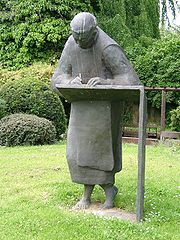
Caesar of Heisterbach
Encyclopedia

Prior
Prior is an ecclesiastical title, derived from the Latin adjective for 'earlier, first', with several notable uses.-Monastic superiors:A Prior is a monastic superior, usually lower in rank than an Abbot. In the Rule of St...
of the former Cistercian Heisterbach Abbey
Heisterbach Abbey
Heisterbach Abbey was a Cistercian monastery in the Siebengebirge near Oberdollendorf in North Rhine-Westphalia, Germany.-Petersberg:...
, in the Siebengebirge
Siebengebirge
The Siebengebirge is a German range of hills to the East of the Rhine, southeast of Bonn, consisting of more than 40 mountains and hills. It is located in the municipalities of Bad Honnef and Königswinter. It is of volcanic origin and came into being between 28 and 15 million years ago...
near the little town of Oberdollendorf
Oberdollendorf
Oberdollendorf is a suburb of Königswinter, a town and summer resort in the Rhein-Sieg district, in North Rhine-Westphalia, Germany. It is situated between the right bank of the Rhine and the Siebengebirge mountain range...
, Germany.
He is best known as the compiler of a book of hagiography
Hagiography
Hagiography is the study of saints.From the Greek and , it refers literally to writings on the subject of such holy people, and specifically to the biographies of saints and ecclesiastical leaders. The term hagiology, the study of hagiography, is also current in English, though less common...
that contains many wondrous tales of miracle
Miracle
A miracle often denotes an event attributed to divine intervention. Alternatively, it may be an event attributed to a miracle worker, saint, or religious leader. A miracle is sometimes thought of as a perceptible interruption of the laws of nature. Others suggest that a god may work with the laws...
s in the form of dialogues between a monk and a novice, the Dialogus magnus visionum ac miraculorum, which is a consistently readable and entertaining, if somewhat sensationalistic and credulous, compilation of that lore. The work was often referred to by preachers seeking material for sermons in the Late Middle Ages
Late Middle Ages
The Late Middle Ages was the period of European history generally comprising the 14th to the 16th century . The Late Middle Ages followed the High Middle Ages and preceded the onset of the early modern era ....
. The work was popular and was widely distributed, showing that it catered well to the tastes of the times; it was perhaps the second largest late mediaeval best-seller, second only to the Golden Legend
Golden Legend
The Golden Legend is a collection of hagiographies by Jacobus de Voragine that became a late medieval bestseller. More than a thousand manuscripts of the text have survived, compared to twenty or so of its nearest rivals...
of Jacobus de Voragine
Jacobus de Voragine
Blessed Jacobus de Varagine or Voragine was an Italian chronicler and archbishop of Genoa. He was the author, or more accurately the compiler, of Legenda Aurea, the Golden Legend, a collection of the legendary lives of the greater saints of the medieval church that was one of the most popular...
. A vision reported in the book provided the source for the iconography
Iconography
Iconography is the branch of art history which studies the identification, description, and the interpretation of the content of images. The word iconography literally means "image writing", and comes from the Greek "image" and "to write". A secondary meaning is the painting of icons in the...
of the Virgin of Mercy
Virgin of Mercy
The Virgin of Mercy is a subject in Catholic art, showing a group of people sheltering for protection under the outspread cloak of the Virgin Mary. It was especially popular in Italy from the 13th to 16th centuries, often as a specialised form of votive portrait, and is also found in other...
.
Caesarius of Heisterbach is also remembered for a maxim on the rise and fall of monasteries; he wrote that discipline causes prosperity in a monastery, and prosperity undermines discipline. He also gave the name of Titivillus
Titivillus
Titivillus was a demon said to work on behalf of Belphegor, Lucifer or Satan to introduce errors into the work of scribes. The first reference to Titivillus by name occurred in Tractatus de Penitentia, c. 1285, by Johannes Galensis, John of Wales...
as the demon
Demon
call - 1347 531 7769 for more infoIn Ancient Near Eastern religions as well as in the Abrahamic traditions, including ancient and medieval Christian demonology, a demon is considered an "unclean spirit" which may cause demonic possession, to be addressed with an act of exorcism...
who allegedly caused typographical error
Typographical error
A typographical error is a mistake made in, originally, the manual type-setting of printed material, or more recently, the typing process. The term includes errors due to mechanical failure or slips of the hand or finger, but usually excludes errors of ignorance, such as spelling errors...
s in the work of scribes.
The priory was dissolved in 1803, when the library and archives were given to the city of Düsseldorf
Düsseldorf
Düsseldorf is the capital city of the German state of North Rhine-Westphalia and centre of the Rhine-Ruhr metropolitan region.Düsseldorf is an important international business and financial centre and renowned for its fashion and trade fairs. Located centrally within the European Megalopolis, the...
; the monastery and the church were sold and torn down in 1809. Though only the ruined apse, with the remnants of the choir remained, in 1897 a monument was erected nearby in his honour.
External links
- Catholic Encyclopedia: Caesarius of Heisterbach
- Medieval Sourcebook: Caesarius of Heisterbach, from Dialogus, book V: on medieval heresies
- Dialogus Miraculorum, volume 1, images from an 1851 edition (Latin)

